Environmental protections and coronavirus restrictions have combined to limit what should have been a bumper year for the Wash cockle fishery. John Worrall reports
Let’s start with a list:
- Special Area of Conservation (SAC) under the EU Habitats Directive
- Site of Special Scientific Interest (SSSI)
- Ramsar site no. 395 (one of a worldwide network of wetland sites, particularly those with waterfowl habitat)
- Marine Protected Area (MPA) – protected area for birds under the EU Birds Directive.
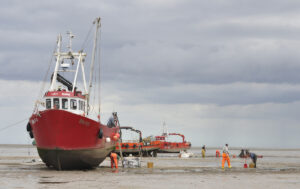
This year’s Wash cockle fishery opened on 22 June with a TAC of 3,636t.
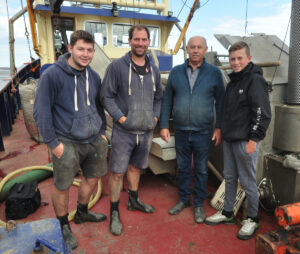
The Brewster family aboard Ruby Doo for a brew-up while waiting for the tide to come back. Wayne, skipper of Ruby Doo (second left), with his son Owen, skipper of Tracey Elaine (left), father Roy and nephew Liam.
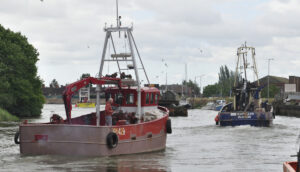
The Boston boats leave port an hour after high tide…
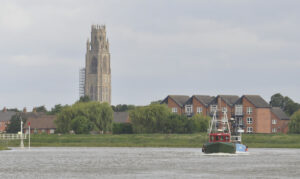
… and head down The Haven, with the Boston Stump astern…
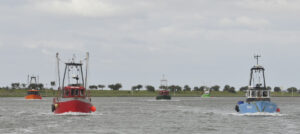
… and out into the Wash.

Reaching the Toft sand in a burst of summer sunshine…
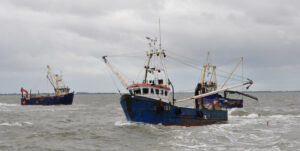
… they churn around, doing a spot of prop-washing…
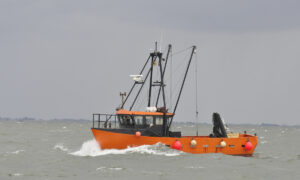
… which, in choppy conditions, can damage the smaller boats as they settle on.
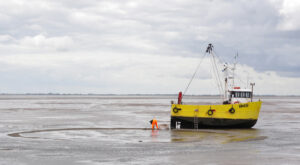
As soon as the water’s gone, it’s over the side, hoping that the boat has settled where the prop has washed – which Shane Bagley’s Lili-Mae BN 439 has done.
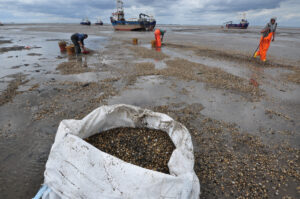
Then it’s a question of raking into hand-nets, which are emptied into baskets…
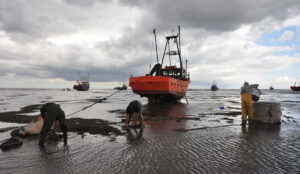
… which are emptied into standard 1t bags…
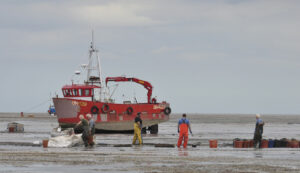
… or direct from hand-nets to bag. A few duck boards help…
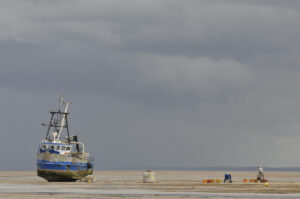
… and a bit of labour-sharing makes things more sociable.

Small boats under big skies: there is a 14m length limit in the Wash.

Loading up on Ken Bagley’s Lucy Marie BN 80…
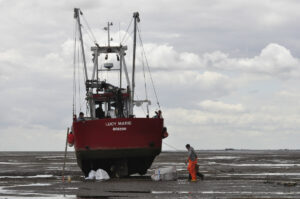
… ahead of the turning of the tide.
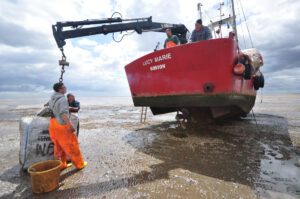
Winching the 1t bags onboard Lucy Marie.
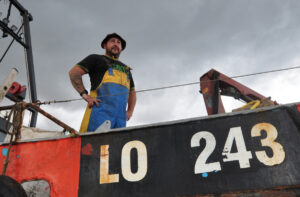
Stacy Ruck on his U12 Jo Bert LO 243.
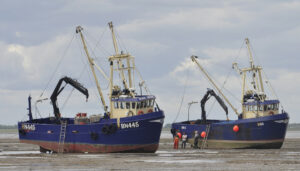
A brace of Brewster boats: Seven Sisters BN 445 and Tracey Elaine BN 5.
The Wash has a comprehensive collection of environmental protections forming a backdrop against which all activities, including fishing, must operate (unless, of course, they are of ‘overriding public interest’, like wind farms, power cables and aggregate dredging – which do plenty of damage, especially the dredging, but bring money to the Crown Estate).
And Brexit or not, EU directives will still be directing after the UK leaves in January, because existing ordinances will be rolled over into UK law, to be reviewed – or not – later.
The common thread within those protections is birds. The 62,000 hectares of the Wash host a lot of them, more particularly in winter when, according to the latest Wetland Bird Survey data, 24,000 or so feed there, mainly on cockles and mussels. And since mussels have declined for reasons not fully understood, cockles are the thing. A total stock of close to 18,000t was reckoned to be needed this year if the birds’ one-third share (along with a third each for the industry and regeneration) was to be adequate for their sustenance.
The numbers – the birds and the food requirement – are recalculated regularly, but the situation this year has been complicated by Covid-19, which has meant, among other things, that Eastern IFCA was unable to do its usual spring cockle survey. On that survey hang the prospects for a fishery each year, because Natural England, the enforcer on the above ordinances, has to be sure of enough bird food if a fishery is to take place. In theory, no survey, no fishery.
In the event, EIFCA was later able to have an abbreviated look, taking samples from 74 sites spread across eight beds, rather than the usual 1,200-plus over 22. Those 74 sites covered 50% of the beds where the 2018 year-class cockles had survived to be seen in the 2019 survey, and so gave a good indication of what overall stocks would look like in 2020. Combined with previous years’ data and trends, EIFCA was able to persuade Natural England that there would indeed be enough for the birds, and so fishing began on 22 June with a TAC of 3,636t.
One frustration for fishermen is that for many years now, Wash cockles have produced a big spatfall every second year which yields a strong potential fishery two years on – there’s no minimum commercial size as such, but a 14mm shell width, regarded as maturity, is generally achieved in two years – and 2020 was due to be a big year. And the pattern has continued with another big spatfall this year, which was observed three or four weeks earlier than usual, perhaps because of a mild winter.
But big spatfalls themselves produce a problem. The bivalve common cockle Cerastoderma edule lives just below the sand or mud surface and filter-feeds on whatever the tide brings. Its spat, released in late spring/early summer (too late to be picked up by spring surveys), turn to larvae that stay in the water column for up to six weeks – long enough to spread widely in the tidal swirl of the Wash.
The problem is that as the spat settles and grows during its first year, it forces mature cockles out of the sand or mud where – more particularly in hot weather on exposed banks – they die in large numbers. Food availability for overwintering birds is thus depleted, which pushes Natural England into a precautionary approach, because its brief, first and foremost, is to ensure that – to adapt a saying – the feathered classes have no cares; whoever loses, they get their share.
Cockling in the Wash goes back a long way. For generations it was hand-raked without regulation by men working from small boats or, where beds were accessible from the shore, from horse-drawn carts by those who knew the ground and tides.
There was still little regulation by the 1970s although, still hand-raked, the fishery had long been working with engines rather than sails, and ‘prop-washing’ was the thing – boats circling tightly as the tide fell before settling on, with the prop blowing the thin blanket of covering sand to reveal the cockles.
A big step-change came in 1986 with the advent of hydraulic suction dredging, and by 1988, 32 bigger steel boats were at it, each lifting 3t an hour and carrying off 10t – all done at the top of the tide, with no waiting around for the tide to go out and come back.
But that eventually put pressure on stocks, and so in 1990, MAFF and the then Eastern Sea Fisheries Joint Committee instituted annual surveys and began bed closures, and brought forth the Wash Fishery Order 1992 with more formalised fishery management.
In any case, the dredge fishery had problems with simple mechanics. Firstly, the blade necessarily dug a few centimetres into the sand or mud and scooped up everything indiscriminately, and although undersized cockles were returned by riddling, many hadn’t survived the battering in the suction pipe.
Secondly, its efficiency meant that, with a daily limit then of 8t, a TAC could be fished out in two or three frantic weeks, and hard luck on any boat that had a breakdown and missed out on the action.
In the mid-noughties, the daily boat quota was reduced to 4t, but things were no less frantic, even though a hand-raked fishery with a separate TAC and a daily quota of 2t was worked by boats that hadn’t invested in – or weren’t big enough to carry – dredge gear.
But now things have turned full circle, because the last dredge fishery took place in 2008 and hand-raking is the default method – though prop-washing still saves labour. And in fact the circle is now on a different plane, because the first and overriding consideration is that the summer fishery leaves more than enough to feed overwintering birds.
They feed by breaking or prising shells open, but there is a trade-off in cockle selection. Bigger cockles give greater return per item, but stronger shells can damage beaks. Equally, thieving gulls are more likely to grab bigger cockles once they are opened, so when gulls are around, oystercatchers in particular have been seen to go for smaller cockles, which are more quickly opened and eaten.
The management strategy each year, once EIFCA has agreed the TAC with Natural England, is to open beds where previous experience and the latest data suggest that mass die-off is likely – on the basis that if it’s unlikely to survive for overwintering birds anyway, the industry might as well have some of it.
But in this Covid year, there’s inevitably a sense of ‘best of a bad job’ about things. The most obvious die-off candidate beds which have been opened are on the Boston side, which means that boats from King’s Lynn have up to two and a half hours steaming to reach them.
In early July, Fishing News went – socially distanced, of course – to see the fishery, travelling out with Ken Bagley on Lucy Marie BN 80, and back with Wayne Brewster on Ruby Doo BN 3. Those boats were among a couple of dozen working the Toft sand that day – others were working other sands – each returning to their respective small marker buoys showing where they had been working the day before.
The Toft, coincidentally, was the ground that FN saw on a previous trip in 2015 (Fishing News, 6 August, 2015), and the first impression was that cockles weren’t so thick on the ground as before – although with limited other options, boats had been working that particular sand, as tides allowed, since the fishery opened.
But the main thing is that a fishery has opened at all, said Steven Williamson of processor and boat owner Lynn Shellfish, who is one of six industry members of the 20-member Eastern IFCA.
“EIFCA did a good job persuading Natural England to open without a proper survey due to corona,” he said. “But fishermen are reporting an abundance of cockles on lots of beds that we are unable to fish because EIFCA was only able to open a few due to that lack of a survey. We could have had a higher TAC, and those cockles, in all likelihood, will be lost before next season. ‘Mr Corona’ has a lot to answer for!”
It’s a view echoed by Gary Taylor, skipper of the Lynn Shellfish boat Wash Princess LN 161. “There are really only three beds open, plus bits and pieces,” he said. “We’re running out here already. That isn’t all EIFCA’s fault, not being able to do a survey. But they should be able to do more surveying now, surely. Consulting with Natural England is, I think, only a two- or three-week process.”
Wayne Brewster agreed. “I think now that the lockdown is being eased, they could do more survey work. Cockles were already dying before the season started. If it had opened in early June, a lot could have been taken, rather than left to die.”
His boat is one of five in his family, all of them close to the 14m length limit for the Wash, but he thinks that smaller boats need particular consideration.
“They should be allowed to fish more sheltered ground closer to their own side. If there’s bad weather, they still have to go because the TAC is being taken up. But on exposed ground, choppy conditions bang the boat on the sand as it’s settling on, and over time, that can crack the welds. Bigger boats can tolerate that more, but the smaller guy has to make a living too.
“There are thick beds of mature cockles close to both ports, but because EIFCA hasn’t been able to survey those, we’re not going to get those cockles, because they won’t be there next year.
“I’m not saying that EIFCA hasn’t done a good job in actually getting a fishery at all, but in the old Eastern Sea Fishery days prior to the IFCA, you’d see fishery officers on the sands nearly every week. Now EIFCA has only so much money to do the job, and they don’t survey anywhere near as much. Huge amounts of cockles are being lost.”
His father Roy Brewster, who is also a member of EIFCA, although he’s stepping down soon, is old enough to know the pattern. “Normally every second year is good fishing. This year should have been a big quota, but because they haven’t done a full survey, we haven’t got it – so a lot will die.”
The cockle situation feeds into growing uncertainty about the Wash fishery generally. Mussels – the traditional winter fishery to complement summer cockles – haven’t been much in commercial evidence in recent years, while shrimps, the year-round fall-back, with an autumn peak and a lesser spring peak, are facing ground closures as environmental protections tighten.
You can then add rising anxiety surrounding the expiry, in early January 2023, of the 30-year Wash Fishery Order (WFO), which fixes the number of boats fishing the Wash through an entitlement system. Its replacement seems likely to be an as-yet-unspecified permit scheme, which on the face of it could go either way – allowing more boats in, or reducing the numbers already there.
Stacy Ruck, owner/skipper of the U12 Jo Bert LO 243, is worried about that. “I do believe the WFO needs tweaking, but it’s worked for 30 years, and so why get rid of it? If it ends, I think that will put an end to this job – not straightaway perhaps, but within a year or two. And then there go the lorry drivers, the factory workers, and all the rest working off it.”
He struggles to see a future. “Mine’s a smaller boat. Those bigger boats don’t lose so much time to bad weather as we do. Last season, EIFCA took something approaching 1,000t off us at the end, because of worries about enough bird food. They wrote saying we had four days left. But one of those days was too rough for this boat. With uncertainty like that, how can you be sure of supporting a family?”
Ken Bagley agrees. He’s chair of the Boston Fishermen’s Association, and has been fishing for 60 years. “There are cockles as thick as gravel on some beds, but we can’t fish them, and they’ll die. And when we started this year, the weather was so hot that we were trying to keep the cockles cool in the bags with the deck hose – but then you finish up overweight at the quay and get a summons.”
“Years ago, all we had was two fishery officers on the mussels. There were no rules on the cockles. But now there are no mussels – and I used to turn over £70k a year on them.”
At his time of life, he’s not worried for his own future – but he can’t see one for aspiring lads. “Before long, no one will own a fishing boat except the processors. The private man won’t be able to afford it. I’ve got two grandsons, but I talked them away from the job. One’s in America, and one’s a school teacher here. You can’t get a mortgage on this job now.”
His brother Steve Bagley, on Sovereign BN 19, agrees, pointing to the narrowing of the fishery, both in time and species. “In the old days, the resorts wanted cockles for the start of the summer season, and so we started fishing earlier. But now we’re pushed back further into summer, with so much pressure on the one fishery. Every single boat is cockling. The boats have got bigger, better and more efficient, and the Wash is still the same size it was a hundred years ago. So it can only take so much pressure.
“But we also used to go for skate in summer and sprats and herring in winter – but quotas now aren’t worth the effort. Cockling is now the main fishery to try to get a wage. The diversity has totally gone out of the job.
“All we’re trying to do is get something a little more concrete for the lads who are coming through. A lot of youngsters would want the job if it wasn’t so precarious. They need a year’s work out of it. It’s no good just going cockling for three or four months.”
There are two levels of industry risk here. On one level are the processors, two in Lynn and one in Boston, which are the conduit through which Wash shellfish reaches the end consumer. They own boats and employ skippers, as well as being supplied by others – but the ratcheted shrinking of catching opportunity is not the entire story for them, because income also flows from processing and onward sale. However, that still needs adequate supply, and with almost all sales going abroad, the final – and as yet unfathomed – post-Brexit landscape will be a factor.
On the other level are the owner/skippers, the family businesses that have historically formed the core of the Wash industry, drawing in lads who aspired to eventually be more than employees. It is that model which is slowly being starved.
It was built on breadth of opportunity, where small boats caught whatever was available, finfish as well as shellfish, and skippers could work whatever the seasons brought. But it has long since been narrowed to shellfish, and of the three main components of that, mussels have all but disappeared, and with them the lays – ground rented, typically in lots of up to 10 hectares, through EIFCA from the Crown Estate, on which seed mussels were laid and grown on, and which, over the past few decades, generated reasonably controllable revenue streams.
Meanwhile, the Wash shrimp fishery, which ironically has just achieved MSC certification, is facing increasing ground closures to its mobile gear, as more conservation-designated features – Sabellaria spinulosa et al – are located.
But at this time of year, it’s all about cockles and the waste of resource. Sure, the late part of the 20th century saw the advent of – by some lights – rapacious cockle dredging, but the errors of that way were recognised and phased out, and today’s 2t daily allowance has evened opportunity between bigger and smaller boats.
The problem now is more one of increasing regulation and thinly resourced regulators. EIFCA has said that it can’t do more surveys this year, although it is watching two particular areas for ridging out and die-off, and will open them if appropriate – but cockles from those would still be within the existing TAC.
And that points to the necessarily inflexible nature of a system governed by a backdrop of environmental protections. When ridging out starts and the weather turns warm, there isn’t much time before cockles start to die, and in an ideal world, the beds would be monitored regularly enough for the industry to move quickly to salvage what it could. But any departure from an agreed TAC – in any year, let alone this Covid situation – would, in most circumstances, require another Habitats Regulation Assessment to Natural England, and by the time that was done, ridged-out cockles would be reduced to dead shells.
And so the precautionary principle is allowing thousands of tonnes of cockles to die without benefit to man or overwintering feathered beast. EIFCA can step back and say, “Not us, guv, it’s the legislation, and we’re spread too thinly anyway,” – both of which are true – while Natural England strokes its beard and shakes its head for fear of being pecked by NGOs. But the net result is that the fleet is being eased out of the Wash ground like so many mature cockles infiltrated by spat.
So it’s not an ideal world, is it?








